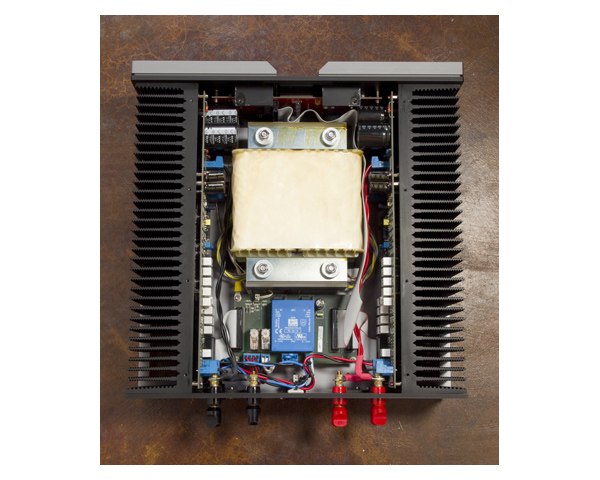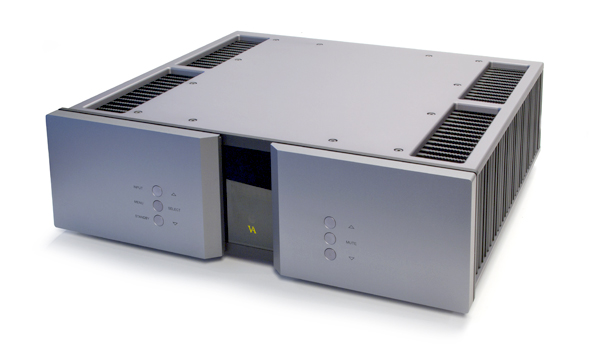 Everything Hans-Ole Vitus makes is heavy. Really fucking heavy. Break-your-back heavy. But those who possess the strength to lift his SM-010 monoblocks out of the boxes will be rewarded with fantastic sound. That said, it’s become very popular of late, at least in the United States, to take shots at the wealthy and, in particular, at luxury goods. So if the idea of a $40k pair of amplifiers seems offensive, let fly the invective and take a pass.
Everything Hans-Ole Vitus makes is heavy. Really fucking heavy. Break-your-back heavy. But those who possess the strength to lift his SM-010 monoblocks out of the boxes will be rewarded with fantastic sound. That said, it’s become very popular of late, at least in the United States, to take shots at the wealthy and, in particular, at luxury goods. So if the idea of a $40k pair of amplifiers seems offensive, let fly the invective and take a pass.
While my bias leans towards vacuum-tube gear, the finest Class A solid-state amplifiers (like the recently reviewed Pass Labs XA160.5s) offer equal palpability and don’t require having to regularly forage for tubes. Heat is the only drawback to Class A units. They are power-hungry animals, but wildlife worth feeding.
Vitus gear not only feels powerful, it looks powerful just sitting on the rack. Also available with massive red-, gold-, or black-anodized front panels, our SM-010 review samples were anodized in a stunning shade of dark gray. I’d love to see more manufacturers adopt this trend. Apologies to the Oakland Raiders, but haven’t we had enough silver and black?
Beneath the SM-010’s top panel lurks a masterpiece of modern know-how—a tidy circuit layout revealing clean electrical and mechanical design. Top-grade parts are used throughout. An enormous power transformer, custom designed for Vitus, is a work of art in its own right—and not the usual toroid that exists in most other amplifiers. Individual amplifier boards, connected directly to the circuit boards to keep signal paths as short as possible, are to the left and right of the power supply.
A solitary XLR input, along with the standard IEC power connection and two speaker outputs to facilitate bi-wiring, makes it easy to integrate a pair of SM-101s into any system. These beasts can be used as 100-watt-per-channel amplifiers in Class-AB mode or 40-watts-per-channel amps in Class A mode. With every speaker, save the Magnepan 1.7s, Class A mode yields enough power for all but the most intense listening.
 Flick of the Switch
Flick of the Switch
The SM-010s power up in AB mode but can easily be switched into Class A via the remote control or front panel. Yes, my inner Homer Simpson loves any adjustments that can be done from the comfort of a listening chair—it really does make the evaluation process easier. When switched to Class A, the change in the amplifiers’ performance is slightly more than subtle, acting as a tube amplifier does when switching from pentode to triode mode. Unlike all the tube amplifiers I’ve auditioned that offer this function (and make a loud ker-chunk sound when altering modes), the Vitus effortlessly and silently switches between A and AB, making sonic inspections all the more interesting. And while engaging triode mode with a vacuum-tube amplifier usually bestows more midrange lubricity, it comes at the expense of bass control. The SM-010s require no such sacrifice.
Again, like a tube amplifier, the SM-010 needs a solid hour or two for the slight initial haze to dissipate. While not green in practice, if you want to experience the best it has to offer (especially in Class A mode), leave the amps on for a day before you begin critical listening. However, prepare to see a bump in your electric bill the following month!
Listen to This
On “Hear My Train A-Comin’” from Jimi Hendrix’s recent Winterland compilation, the Vitus’ deliver the virtuoso’s distorted guitar in spades and Noel Redding’s bass playing in a way I’ve never experienced. Textures in the latter blend with the distortion, the mix growling as if emanating from the band’s vintage Ampeg amplifiers. Metallica’s so-called “Black Album” offers similar revelations when cranked up. The plucked bass line in “Nothing Else Matters” flaps my pants leg as it does at a Metallica concert. All six of my GamuT woofers work strenuously and, yet, stay controlled. I’ll trade all the string quartets in the world for five minutes of this experience, and the Vitus amplifiers grant my wishes. After a full day of seriously heavy music (that, admittedly, to the disappoint of editor Bob Gendron, did not include any St. Vitus albums), these amplifiers cannot be broken. Moreover, while they got extremely warm, their sonic character did not change.
Big solid-state power normally promises stout bass response, and the SM-010s prove no exception to the rule. Yet these amplifiers’ innate ability to unveil layer after layer of musical performances melts brain cells. If you have speakers as equally revealing as the SM-010s, you’re in for a fatigue-free experience—no matter how high or low the listening level.
Indeed, classical music aficionados will relish the delicacy with which the Vitus’ render string and wind instruments. My GamuT S9s feel like big headphones when I listen to the oboes in the Netherland Wind Ensemble’s Beethoven Wind Music. For me, texture and nuance are the chief characteristics that turn listening sessions into musical events. With the SM-010s in my system, I’m still going to great lengths to listen to records I’ve heard hundreds of times to see if I can mine new aural data.
Great amplifiers also magnify differences between mediocre recordings and standout efforts. Score another victory for the SM-010s. Used extensively in TONEAudio’s Pink Floyd coverage for Issue 40, the Vitus’ exposed subtle nuances between various Dark Side of the Moon pressings as if merely presented with apples and oranges.
Whether in AB or A mode, the SM-010s exhibit dead-quiet backgrounds with zero noise when used in conjunction with the equally silent Vitus preamplifier. When mated with my ARC REF 5 and REF PHONO 2, there’s a slight bit of tube rush—but nothing from the Vitus. This makes for a dynamic presentation, and contributes to the amplifiers always sounding much bigger than you’d expect 40-watt monoblocks to sound. They actually remind me of my favorite amplifiers from the 80s—Mark Levinson ML-2s—but boast healthier depth and detail.
The SM-010s also excel at precise acceleration and deceleration, never blurring transients. Vide, Morris Pert’s lightning-fast percussion runs in “The Poke,” from Brand X’s Masques. The amps’ perfect pace separates the percussion from the rapid-fire drumming, each keeping control of its own space. Such ability to instantaneously start and stop significantly contributes to the SM-010’s non-fatiguing sound.
Other Synergies
Partnered with my reference GamuT S9s, the SM-010s are in many ways the equal of my reference Burmester, Pass Labs, and ARC amps but, nonetheless, retain their own sonic signature. While each amplifier has its own virtues and near-faultless performance, the Vitus amplifiers thrive in their ability to resolve great detail without ever becoming fatiguing—even after full-day listening sessions.
While mixing and matching, I discovered a few synergies to be unmistakably good. For example, the B&W 802 Diamonds are completely different speakers when used in concert with the SM-010s. Normally, the 802 is very revealing and, when married to an amplifier that is either harsh or forward, mirrors the amp’s presentation. With the 802s, the Vitus sounds particularly tube-like in the upper registers, replete with the slam and control you expect from a powerful solid-state amplifier.
Heard through this combination, Keith Jarrett’s Shostakovich: 24 Preludes and Fugues, Op. 87 possesses extra depth and decay, sounding more realistic than I recall—especially on the opening “Prelude & Fugue No. 1 in C Major.” While Shostakovich is traditionally a forceful composer, this piece assumes a wistful delicacy through lesser amplifiers, as Jarrett’s light touch becomes lifeless and flat. The ultimate test? Play the composition at the low volume it demands. The Vitus passes with proverbial flying colors.
B&Ws aside, the oddest albeit most interesting combination I experienced with the SM-010s occurred with the compact Penaudio Cenya speakers. Most people would not mate a $40k pair of amplifiers with a $4,000 pair of speakers, but hey, why not give it a try? The Cenyas sounded supercharged, disappearing in the room as never before, almost as if a subwoofer entered the equation.
 Not Just Another Brick in the Audio Wall
Not Just Another Brick in the Audio Wall
Some audiophiles argue that speakers are everything to a system, while others, maintaining the garbage in/garbage out theory, believe the source the most important link in the chain. I feel every part is equally important. But I’ve also seen plenty of astonishing speakers and fantastic source components humbled when lacking proper amplification. Truth be told, I’ve heard modest speakers deliver performances I never thought possible when a standout amplifier drives them. So, at the end of the day, I’m an amplifier guy.
A pair of Vitus SM-010 amplifiers will present no compromise to your system no matter the quality of your other components. These behemoths may even inspire you to make a few improvements once you get used to their abilities. While the price is high, it’s commensurate with the level of build and sound quality. Think of the SM-010s as an ultimate audio destination—desert-island tracks optional.
Vitus Audio SM-101 Monoblocks
MSRP: $40,000/pair
Manufacturer Information: www.vitusaudio.com
Peripherals
Analog Source AVID Acutus Reference SP/SME V/Koetsu Urushi Blue
Phono Preamplifier ARC REF Phono 2
Preamplifier ARC REF 5, Burmester 011, Vitus SP-101
Digital Source dCS Paganini Stack, Sooloos Control 15
Speakers GamuT S9, Verity Amadis, B&W 802 Diamond, Magnepan 1.7
Power Running Springs Dmitri, Maxim PLCs, RSA Mongoose Cords
Cable Shunyata Aurora SP
Accessories SRA Scuttle Equipment rack, SRA Ohio XL equipment bases, Furutech DeMag, Loricraft LR-4 record cleaner














